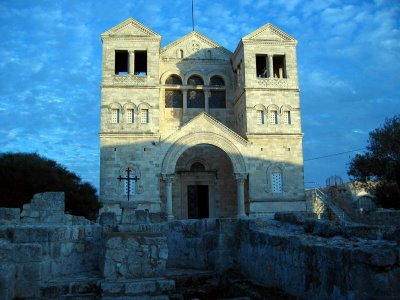 What I Saw In The Holy Land, part 6
What I Saw In The Holy Land, part 6This is the Franciscan Church of the Transfiguration, atop Mount Tabor, which is between Nazareth and the Sea of Galilee. In Jesus’ time I would judge it to be about a half day’s hike to climb the mountain. We accessed it by driving the bulk of the way up, then parking at a little café and souvenir stand (run by bedouins), where you hire stretch taxis to take you up the narrow, winding rest of the road. We had been enjoying unseasonably warm weather for winter, but on the mountain the wind picks up considerably. This Church is modern –1924—but designed in the style of a Middle Ages church, so it “feels” authentic. The grounds are gorgeous, and the wind whips the smell of pine around, so you have the sense of everything being pure and fresh. The pathway in takes you through the ruins of the Crusader-era Church, which used to be guarded by Augustinians until Muslim raiders ran them off in the 12th c., and there are lovely gardens tended now by the Franciscans.
Here's the interior, although I wish you could see the stained glass peacocks at the back of the lower church (all the artwork evokes either the Transfiguration itself or elements of creation that transform in some way.) If you could see through that window, you'd be looking down onto the tiny town of Nain, where Jesus raised the widow's son, and out into the beautiful Jezreel valley, and across the valley to Megiddo or Armageddon, site of many ancient battles --and the Mother of All Battles to come, depending on who you talk to (Catholics read the scriptural end-times prophecies to apply to the destruction of Jerusalem in 70 A.D. and related battles, so for us Armageddon is history, whereas evangelicals think it's still to come). At any rate, if you step out of the Church and walk around, you can indeed look down and see those sites. They look peaceful now, although you can see how the plain provides an ideal site for the clash of armies. No wonder Deborah the judge had the Israelites come here to conquer the Canaanites: smart tactician. I wonder if Peter, James & John would have found it significant that Christ chose a mount overlooking Armageddon to give them a glimpse of his divinity?
However, my thoughts were not of battles when I was here, but of glory. You can't get the full effect now because the roof is covered, but in the original design the roof is alabaster, and chapels are created to catch the afternoon sun just so, illuminating the mosaic in the upper chapel and hinting at the glory in which Christ was transfigured. We didn't get to see that, but the weather provided something almost as good: namely, while we were here, clouds rolled in and we found ourselves surrounded in mysterious-looking fog --an excellent aid to contemplating Christ and the disciples being caught up in a cloud together with Moses & Elijah.
Here as in many churches in the Holy Land, people have adopted the practice of Jews at the Wailing Wall of scrawling prayers on papers and leaving them at the holy sites. In the lower chapel in front of the altar is a trap door that exposes some of the mountain itself, so we all sat in silent prayer for awhile before leaving our petitions there. The approximately 15 Germans travelling with us seemed to have a gorgeous hymn for every occasion of Christ's life, and they sang sweetly about the Transfiguration in 3-part harmony, which only added to a certain spell that seemed to be cast. Like Peter, before me, I had no desire to leave this spot. It seemed peaceful, pure, happy. I noted, too, that thanks to the Franciscans there are indeed three chapels here now: one for Christ, one for Moses, one for Elijah --just as Peter desired. Hmm. The scriptures say Peter didn't know what he was talking about when he asked for that. (Photo credits.)


